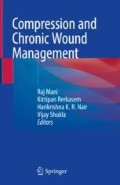Abstract
Patients suffering from venous disease may encounter situations which render compression treatment challenging at least temporarily while complications are managed.
Aside from the skin changes and/or ulceration itself, the leg can present anatomical or functional problems, like skin atrophy or impaired mobility, frank deformity or scarring. Motivation and ability to self-management are personal factors which play a role; other challenges may come from the patient’s socio-cultural or economic situation. Even motivated people may become discouraged by working demands/circumstances or by climatological factors. Temporary or remaining concurrent medical problems may be diagnosed to be contra-indications for standard compression treatment. In regions where there is a paucity of skilled caregivers, instruction of the appliers or of the patient itself, and follow-up of treatment may be difficult to arrange. Availability of materials is not always evident in some countries or in some of their remote regions due to issues of marketing and infrastructure. The same holds for provision and organisation of care, rendering optimal compression therapy too exceptional and/or too expensive.
These challenges by themselves or in combination, are the main reason to making it difficult to compress legs with venous disease.
Access this chapter
Tax calculation will be finalised at checkout
Purchases are for personal use only
References
Ramelet AA, Perrin M, Kern P, Bounameaux H. Phlebology. 5th ed. Masson: Elsevier; 2008.
National Health and Nutrition Examination Survey. www.cdc.gov/nchs/nhanes.htm.
Mosti G, De Maeseneer M, Cavezzi A, Parsi K, Morrison N, Nelzen O, Rabe E, Partsch H, Caggiati A, Simka M, Obermayer A, Malouf M, Flour M, Maleti O, Perrin M, Reina L, Kalodiki E, Mannello F, Rerkasem K, Cornu-Thenard A, Chi YW, Soloviy M, Bottini O, Mendyk N, Tessari L, Varghese R, Etcheverry R, Pannier F, Lugli M, Carvallo Lantz AJ, Zamboni P, Zuolo M, Godoy MF, Godoy JM, Link DP, Junger M, Scuderi A. Society for Vascular Surgery and American Venous Forum Guidelines on the management of venous leg ulcers: the point of view of the International Union of Phlebology. Int Angiol. 2015;34(3):202–18.
Eklöf B, Bergan JJ, Carpentier PH, et al. Revision of the CEAP classification for chronic venous disorders. A consensus statement. J Vasc Surg. 2004;40:1248–52.
Raju S, Hollis K, Neglen P. Use of compression stockings in chronic venous disease: patient compliance and efficacy. Ann Vasc Surg. 2007;21(6):790–5.
Neumann HA, Cornu-Thénard A, Jünger M, Mosti G, Munte K, Partsch H, Rabe E, Ramelet AA, Streit M. Evidence-based (S3) guidelines for diagnostics and treatment of venous leg ulcers. J Eur Acad Dermatol Venereol. 2016. https://doi.org/10.1111/jdv.1_13848.
Partsch H, Flour M, Coleridge Smith P, et al. Indications for compression therapy in venous and lymphatic disease. Consensus based on experimental data and scientific evidence. Under the auspices of the IUP. Int Angiol. 2008;27:193–219.
Mosti G, Cavezzi A, Partsch H, Urso S, Campana F. Adjustable Velcro® compression devices are more effective than inelastic bandages in reducing venous edema in the initial treatment phase: a randomized controlled trial. Eur J Vasc Endovasc Surg. 2015;50:368–74.
Williams A. A review of the evidence for adjustable compression wrap devices. J Wound Care. 2016 May;25(5):242–7. https://doi.org/10.12968/jowc.2016.25.5.242.
Blecken SR, Villaviciencio JL, Kao TC. Comparison of elastic versus nonelastic compression in bilateral venous ulcers: a randomized trial. J Vasc Surg. 2005;42:1150–5.
Author information
Authors and Affiliations
Editor information
Editors and Affiliations
Rights and permissions
Copyright information
© 2019 Springer Nature Switzerland AG
About this chapter
Cite this chapter
Flour, M. (2019). Difficult to Compress Legs with Venous Disease. In: Mani, R., Rerkasem, K., Nair, H., Shukla, V. (eds) Compression and Chronic Wound Management. Springer, Cham. https://doi.org/10.1007/978-3-030-01195-6_4
Download citation
DOI: https://doi.org/10.1007/978-3-030-01195-6_4
Published:
Publisher Name: Springer, Cham
Print ISBN: 978-3-030-01194-9
Online ISBN: 978-3-030-01195-6
eBook Packages: MedicineMedicine (R0)

